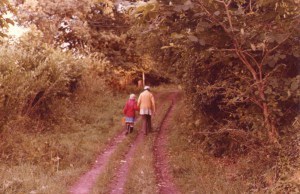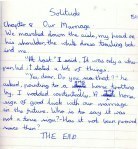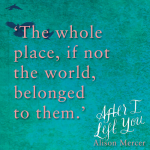Alison Mercer's Blog, page 4
June 14, 2014
The new cover of After I Left You
After I Left You has a new look! This is the cover design for the paperback, which is due out at the end of July.
I hope you like it. I think it’s a beauty, and captures perfectly a certain kind of sunny afternoon, and the feeling of being free and happy in a golden place and time.
I have this song by George Ezra on the brain at the moment, and the lyrics seem at least partly apt: ‘Give me one good reason why I should never make a change…’
It’s interesting how cover designs can change over time. The initial cover for my first book, Stop the Clock, featured three pairs of legs, representing the three different characters; the career woman, the uber-mum, and the unassuming girl-next-door. This was good fun for me, as I got to help draw up the prop shopping list. In the end, though, it hit the shelves with a quite different look – the lady sipping coffee, reading her newspaper (probably checking out the column written by Tina, the career woman, which causes all sorts of problems when her friends think she is writing about them.)
Sometimes covers even feed into a book. There’s a scene in Julie Cohen’s excellent Dear Thing that involves a pair of baby shoes. Julie mentioned that she put the baby shoes into the book after she’d seen the cover design for the hardback, which featured someone holding a pair – it was too good a metaphor to miss!
BIG thank you to everyone who has said kind things about the cover of After I Left You – here are some of the comments – and thank you so much to everyone who has shared it. The response has been lovely and I’m really grateful.
@AlisonLMercer @TransworldBooks Oh it’s beautiful! x
— Samantha Ellis (@SamanthaEllis27) June 12, 2014
@AlisonLMercer @rowancoleman @creativepumpkin Wow, that really is captivating! Lovely.
— Katy Regan (@katyreganwrites) June 12, 2014
@AlisonLMercer @katyreganwrites @creativepumpkin oh stunning!
— Rowan Coleman (@rowancoleman) June 12, 2014
@AlisonLMercer @katyreganwrites @rowancoleman lovely!
— Sarah Rayner (@creativepumpkin) June 12, 2014
@AlisonLMercer @TransworldBooks Love that cover – well done everyone!
— Mark Thornton (@mostlybooksmark) June 12, 2014
@AlisonLMercer @Leanne_Oliver1 @TransworldBooks this looks beautiful!!! *adds to wish list*
— Sam’s book corner (@sam_smith73) June 12, 2014
@AlisonLMercer @TransworldBooks gorgeous cover!
— One More Page (@onemorepage) June 12, 2014
@AlisonLMercer @TransworldBooks Beautiful cover!
— Lindsay Healy (@linshealy) June 12, 2014
@AlisonLMercer @ChickLitChloe @TransworldBooks Love this, what a beautiful cover.
— Emma Davies (@Emdavies68) June 12, 2014
@AlisonLMercer @pulpthorn Oh beautiful!
— Julie Cohen (@julie_cohen) June 12, 2014
@AlisonLMercer @julie_cohen Wonderful cover!
— Susan Murray (@pulpthorn) June 12, 2014
RT @AlisonLMercer: @AlicePeterson1 After I Left You has a new cover – gorgeous book about first love #afterileftyou pic.twitter.com/Uista9chuP
— Alice Peterson (@AlicePeterson1) June 13, 2014
@AlisonLMercer @TransworldBooks gorgeous…
— Victoria Ralfs (@VictoriaRalfs1) June 12, 2014


May 29, 2014
The After I Left You tour of places in Oxford I love
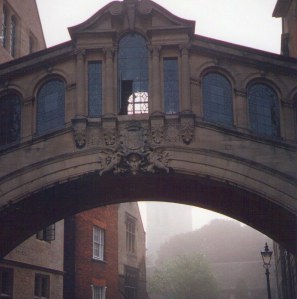
Oxford’s Bridge of Sighs, May morning, early 90s…
I was nervous about setting my new novel, After I Left You, in Oxford, but my editor talked me into it. It’s a challenge to write about a place you love without pretending that it’s somewhere else, especially if it’s very close to home.
In the end, I’m really glad Oxford’s in there. Books need to have avatars of things you feel strongly about in them. It’s as if the book digests your emotional attachments and translates them into something that is no longer personal, but is (hopefully) available to anybody who reads the story.
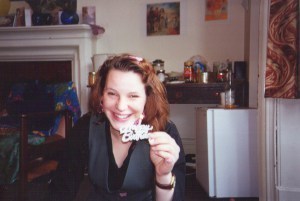
My 20th birthday in Oxford
I did fictionalise Oxford a little, and blurred some of its geography and landmarks. Here are ten things I love about Oxford and the surrounding countryside, and suggest you sample if you go there.
1. Pubs.
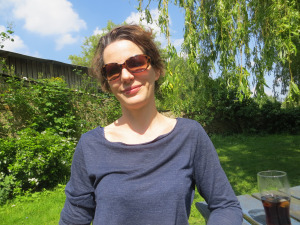
at the Perch in Oxford on a family day out
The Eagle and Child, The Turf and the Lamb and Flag are all lovely, the Perch and the Trout are vital stopping-off points on the Port Meadow walk (see 5), and I have fond memories of some of the Cowley pubs, including The Bullingdon Arms as was (last time I looked, it had turned into a nitespot with girls with shiny dresses.)
But my favourite of all is the King’s Arms, the inspiration for the Wickham Arms in After I Left You, ‘a city pub with a hall of fame of past patrons displayed on its dark green walls: poets, politicians, sporting heroes… captured in dim corners and on banquettes, their features both emphasized and softened by the shadowy, forgiving light.’
I’m pretty sure I had some Moments of Destiny in the King’s Arms. Anna certainly has one in the Wickham Arms in After I Left You.
2. Bookshops.
I love having tea and people-watching in Blackwell’s. There’s always someone nearby tapping importantly on a laptop: writing what? An essay, a novel, a thesis, an email to a lover or a longlost friend? I also love a browse in Waterstones, where I very nearly ended up working after I graduated (I ended up taking a job at the JR hospital instead, as a secretary in the IT department.)
3. Cafés.
My heart belongs to the Queen’s Lane café, which brings back memories of cutting class to eat carrot cake with the indie-music-loving, long-fringed boy of my dreams. My son, who has autism and a fascination for things that go round, loves Brown’s in the covered market for the ceiling fans.
4. Colleges.
I first visited Oxford when I was 10 or 11. I was into dungeon-and-dragons style books at the time, where you had to choose which way to go and then turn to the page to find out if you’d arrived at treasure or a nasty imp. Oxford, with its cloisters and quadrangles and halls, struck me as being a made-up fantasy place like the kingdoms in the books, where anything could be lurking round the corner.
5. Port Meadow.
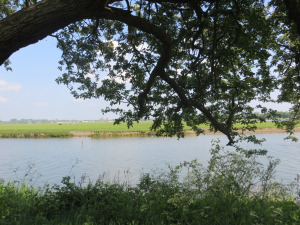
Port Meadow
6. The White Horse.
A friend who read a proof copy of After I Left You said she was waiting for the White Horse to turn up, and sure enough, a version of it does.
On the way back from visiting the ancient chalk landmark, the friends discuss the game of truth or dare they played when they first met, leading to this exchange, which is pretty much the set-up of the story in a nutshell:
‘No one went for truth, then,’ I said.
‘No,’ Clarissa agreed. ‘In the end, no one did,’ and she started the drive back to Oxford.
7. The river.
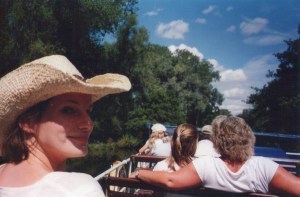
on the boat from Abingdon to Oxford
I love a walk through Christ Church meadows, and the Salter’s Steamers boat trip from Abingdon to Oxford.
In After I Left You, when Anna meets up with her friend Meg and looks through her photo album, she sees a snap of the friends together on a bench near the river: ‘there we all were, squeezed on to a bench overlooking the river on a frosty autumn morning, happy and complete and sure of ourselves, a pack surveying its territory’.
And here’s the cover of the German edition of After I Left You (out in June!) showing what I imagine to be the same bench years later.
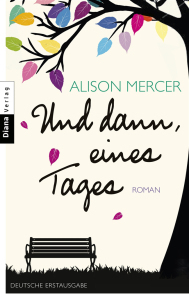
Cover © t. mutzenbach design, shutterstock
If you go punting, in my experience, the trick is to find someone who knows what they’re doing and persuade them to do the punting bit, while you lounge around taking in the scenery and drinking something fizzy.
8. The Oxford University Museum of Natural History and the Pitt Rivers Museum.
Dinosaurs! Shrunken heads! Witchy stuff!
This is where we first meet Keith in After I Left You, ‘standing awkwardly in one of the dinosaur footprints… as if half attempting to strike a pose and half wanting just to get the photo over with.’
9. St Margaret’s Church and St Margaret’s Well.
An otherworldly place, along the lane from the Perch. The well inspired the treacle well in Alice in Wonderland and it’s the model for St. Bartholomew’s well in After I Left You, which is also in a churchyard:
A canopy of leaves sheltered the little congregation of the dead from the wind, the sun and the rain. It was as if we were already inside, if not a church, then some other protected space.

my daughter took this pic near Port Meadow
10. Bleinheim Palace.
It’s a magnificent building, but what I love most about Bleinheim is the view. In After I Left You, there’s a stately home called Shawcross Hall where Keith spends a happy summer showing tourists round the orangery, and where Anna is finally given the chance to confront the past.
I was so lulled by the sun and the champagne and the scent of grass and lavender and roses, and the gentle thud of elderly pop hits issuing from the grand house behind me, that I didn’t even jump when I heard footsteps and realized that someone was about to find me.
What happens next? After I Left You is out in paperback in July and will be available from all good bookstores – but if you can’t wait till then, it’s available for Kindle and in other ebook formats now (click on ‘buying options’ to see the different available formats.)
Five rules for writing an Oxford novel
The two types of love story and After I Left You
After I Left You: the story of my second novel
After I Left You: the ebook comes first
 Something else I love about Oxfordshire, which you can’t help but notice wherever you are, is that it has such big and beautiful skies.
Something else I love about Oxfordshire, which you can’t help but notice wherever you are, is that it has such big and beautiful skies.

Oxfordshire sky, as seen from our house


April 26, 2014
A short list of books to turn to when you’re stressed

from the stressed-out reading list…
A right hotch-potch, this: a former Spice Girl, the Demon Barber of Fleet Street, a titled historian, an academic, an experimental novelist and an Irish poet and playwright looking back on his time in Borstal. These are the people behind the books that have helped me through troubling times.
I offer this list up to you in the spirit of a mixtape, in the hope that if you pass over one item, another may catch your eye and provide some much-needed distraction or solace when you are suffering from insomnia, anxiety or helpless waiting.
(Not a single novel among them!)
Borstal Boy by Brendan Behan
I single this out for the catchy motto: ‘**** the begrudgers’. I find this sentiment helpful.
The Faber Book of Reportage, edited by John Carey
This is one of my most treasured books. It’s a collection of eyewitness accounts of different moments in history. Chiefly, what comes across is how very uncomfortable it is being there when history is made… ‘May you live in uninteresting times…’ Reading it is a very good exercise in perspective.
When I’ve been in a fix, or thought I was, I’ve sometimes found it helpful to be reminded how very much worse things could be. The Assassin’s Cloak, a collection of diary extracts put together by Alan Taylor and Irene Taylor, is fascinating and restorative in the same way.
Demon Barber and Mostly Men by Lynn Barber
You’ll go a long way to find better character studies than these volumes of Lynn Barber’s interviews. Excellent for late-night dipping.
The Weaker Vessel: Woman’s Lot in Seventeenth-Century England by Antonia Fraser
I read this when I was in the late stages of pregnancy with my second child, sleeping badly and not much looking forward to giving birth. Worked in the same sort of way as The Faber Book of Reportage, in that it made me think, well – at least I’m here and now, rather than back then.
Oh – and you know it’s sometimes implied that women back then, at a time of high infant mortality, were used to the idea of babies or children dying, and somehow became less attached to them, or were more hardened to the idea of losing them than we might be, or less distressed? Not so, according to this book. (Of course not. Why would they have been so different? We’re always closer to the past than we think.)
Remainder by Tom McCarthy
I read this when I was staying in hospital with my son, who was three at the time, and suffering from a mysterious and virulent infection (turned out to be a ruptured appendix). It is a strange and strangely compelling book, and helped me to keep from going out of my mind with worry.
Learning to Fly by Victoria Beckham
I read this alone in the waiting-room, late in the evening, while my son was having his appendix removed. His was the last surgery of the day and it took a long time. Posh Spice kept the time passing until I was told the operation was all done and had gone well, and I could go in and see him.
Sometimes, when the dark is really closing in, you don’t feel like reading at all, and all you want is comfort. That’s when it’s time to watch old episodes of Friends…
Anyway, so there it is, a bit of an odd list! I’d love to know what other people like to read when they’re anxious and in need of distraction.


April 18, 2014
Confessions of a terrible baker, and how my mum rescued me

Barm Brack, aka Working Mother’s cake, plus tea and muffins
I have a confession to make – as my children and husband know, I’m a terrible baker. If it wasn’t for them, it’s quite possible that my oven would be used for shoe storage, like Carrie’s in Sex and The City. We’re talking Bridget Jones levels of ineptitude here. My sponge cakes just don’t rise, and I once made tuna pasta without the tuna in. And as for what happened when, as a child, I was left in charge of a pan of simmering rice… Well, of course, I went off to my room to write a story and forgot all about it.
Imagine my dismay, then, when I started a new job and found that my office was full of keen and very expert bakers, and they had a cake club which I was immediately invited to join.
So what did I do? I turned to my mother for help.
This is her recipe for Barm Brack, which she used to make pretty much every week when I was a kid. I think it was originally her mother’s recipe. I promise you, it works, even if you’re really rubbish like me. And it rises into a nice satisfying loaf and makes your kitchen smell all cinamonny. Serve with butter and a nice cup of tea.
I’ve been thinking about this recipe because I’ve been reading Jenny Colgan’s Meet Me at the Cupcake Café (I know, about a million years after it came out), which has lots of recipes in it that are named according to how the heroine is feeling at the time. For me, this cake is Working Mother cake. It’s the cake you can knock up when you’re knackered and it’ll still come out all right. And it makes me think of my mum and my grandma (there’s a pic of me going to collect eggs with my grandma at the end of this post.)
Oh, and my cake club liked it!
Sorry, it isn’t metric. If you want to give it a go, hope you can figure it out, and that the recipe works for you too – let me know!
The pic at the top of this post dates from a bake-off my daughter challenged me to last summer. She made some very delicious muffins. Luckily, thanks to Working Mother’s Cake once again, I wasn’t too badly disgraced.
Happy Easter everybody!
Barm Brack (aka Working Mother cake)
½ pint cold tea
6 oz soft brown sugar
12 oz mixed dried fruit
10 oz self-raising flour
1 egg
Put tea, sugar and fruit in bowl – cover and leave to soak overnight (or for 2 hours!)
Add one teaspoon each of nutmeg, cinnamon and allspice for flavour. (My note – don’t forget this bit! I once did and fished the cake out of the oven to add at the last minute – shades of the tuna-less pasta once more.) Beat egg and stir with flour into mixture. Grease and flour 2lb loaf tin, add mixture and bake in oven, gas mark 4 (180 C) for approx 1 hour/1 hour 10 min.
(PS – when I read How to be a Heroine by Samantha Ellis recently, I came to a bit where she said it wasn’t possible that somebody could be quite so useless in the kitchen as Bridget Jones – it was the bit where Bridget leaves blue stringy packaging on the meat, or does something bad to spaghetti, or something like that. Samantha, I’m sorry to break it to you, but it *is* possible, alas!)
(PPS – luckily for everyone, I married an absolutely excellent cook. I think Sheryl Sandberg should stress the importance of this, if she hasn’t already.)


April 2, 2014
Women writers who changed my life, part II: teens to twenties
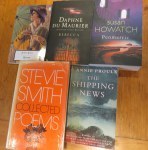
Books by Jean Rhys, Daphne du Maurier, Susan Howatch, Stevie Smith and E. Annie Proulx
These are the women writers who I discovered in the tricky years between my mid-teens and early twenties – tricky because that’s when you begin to figure out for real what kind of woman you are going to be, and also because, if you aspire to be a writer, you are simultaneously trying to work that one out too.
If you are headed for wifedom, will you be a capricious, dangerous Rebecca, or a good, quiet, jealous Mrs de Winter? Will you end up as an occasionally desired and ultimately abandoned Jean Rhys woman, whose prose is all discipline, lucidity and sensuous clarity while her life is a muddle of drink, lovers and poverty?
Or will you be a social butterfly spinster who chats brightly at parties and returns home resolutely alone, as one imagines the narrator of this Stevie Smith poem might do: ‘The nearly right/And yet not quite/In love is wholly evil…’? (The poem ends, ‘Take my advice/ Shun compromise/ Forget him and forget her.’) And if none of these options appeal… what then?
I liked the idea of a piratical Cornish lover who would take you about on his boat, and teach you to catch fish and cook them on an open fire.
Daphne du Maurier. When I was fourteen or so and at my traditional all-girls’ school, which had turned out not to be as much like Malory Towers as I had hoped, we had to pick a book to tell the rest of the class about. I chose Rebecca. I knew it was impregnable; whatever my classmates might think of me, there was no way they could find fault with the book. It was just too compelling. Nowadays I think I might read it differently, with rather more sympathy for Rebecca, and a lot more impatience with Max.
Jamaica Inn also made a big impression, though I was unnerved by it too, and found it sinister – there’s a real sense of lurking menace and threat. Frenchman’s Creek was gentler and sunnier. I liked the idea of a piratical Cornish lover who would take you about on his boat, and teach you to catch fish and cook them on an open fire.
Susan Howatch. Aged 16 or so, I loved Penmarric, Cashelmara and the rest – sagas of rich landed families and their love affairs and bitter rivalries, usually modelled on tracts of British royal history, told in a series of first person narratives so you got a taste of everybody’s point of view – both the men and the women.
So I tried writing my own family saga, which featured a country estate and, er, a series of first person narratives. It began with the point of view of the slightly hopeless Casanova heir of the estate-owning dynasty, who falls in love with rogue redhead Clara but fails to marry her. The opening line was this: ‘I made the same mistakes with Clara that I have made with every other woman in my life: first I fell in love with her and then I fell in love with somebody else.’ The novel petered out and I never finished it, but hey – it was a start.
‘I made the same mistakes with Clara that I have made with every other woman in my life: first I fell in love with her and then I fell in love with somebody else.’
Then my English teacher gave me a reading list with things like the Mitfords on it. I stopped writing and started concentrating on trying to get into Oxford to study English, and didn’t really start trying to learn how to write again till ten years later.
Stevie Smith. She’s better known as a poet – ‘Not Waving But Drowning’ – but I loved Novel on Yellow Paper, with its chatty, discursive, distinctive first-person voice (‘I am a forward-looking girl and don’t stay where I am. ‘Left right, Be bright,’ … my own philosophical outlook that keeps us all kissable.’) Over the Frontier, which was written in the late 30s and is partly set in Germany, is much darker and more ominous: you can feel the storm coming.
I read Novel on Yellow Paper at about the same time I read The Catcher in the Rye, and for the same reason; I’d taken to hanging out in the school library at lunchtime. One of the books I found there was a collection of Stevie Smith’s letters, which were terrific (there was one berating George Orwell for constantly telling small, irritating fibs that would make an angel weep – I paraphrase, but you get the gist.) That led me to seek out NYP for myself. Another school library find was The Catcher in the Rye: it was the perfect time and place to read it.
Jean Rhys writes anti-heroines, and that’s why I love her. Her women turn passivity into an art; they are sensitive to everything, they register everything, and yet they are incapable of taking charge of their own fates. Their only power is the ability to bear witness and give in. They are not good girls, or good women. They don’t know how to play the game, and don’t want to. They’d laugh at The Rules and go off and get crazy drunk and do something wild and helpless and stupid.
I was introduced to Jean Rhys by my mum, who bought me Wide Sargasso Sea because I loved Jane Eyre so much. In my early 20s I sought out the four earlier novels: Quartet, After Leaving Mr Mackenzie, Voyage in the Dark and Good Morning, Midnight.
Oh, but they are good. They are so pared back. I admire Jean Rhys absolutely. I’m a little scared of her darkness and sadness, though. Could anybody else have written the gigolo scene at the end of Good Morning, Midnight? I think not.
Here’s how Jean Rhys saved my bacon: we were all advised to write an optional long essay, a kind of mini-dissertation, which would knock out our worst mark in our Finals papers. I did mine on Jean Rhys. I ended up staying up all night in the computer room to finish it, my view of the PC screen glazed with tears because I’d just had a big row with my boyfriend. But anyway, it turned out OK, and replaced my Shakespeare mark, which was truly awful. So – Jean Rhys, my champion!
E. Annie Proulx. The Shipping News was given to me by a friend who was also setting off for journalism school in the mid-90s, and it was a very apt present, because one of the things Quoyle, the hero, has to learn to do is how to write a good auto wreck story for the local paper.
I still have the page turned over at the part where someone tells Quoyle (who is a hapless gentle giant hero) that there are four kinds of women in every man’s heart: the Maid in the Meadow, the Demon Lover, the Stouthearted Woman and the Tall and Quiet Woman. Seems like as good a summary of female character archetypes as any. I just found the page turned over for this paragraph, too:
Was love then like a bag of assorted sweets passed around from which one might choose more than once? Some might sting the tongue, some invoke night perfume. Some had centers as bitter as gall, some blended honey and poison, some were quickly swallowed. And among the common bull’s-eyes and peppermints a few rare ones; one or two with deadly needles at the heart, another that brought calm and gentle pleasure. Were his fingers closing on that one?
I guess that sums up the dilemma that Anna Jones is trying to resolve in After I Left You… and what all of us are trying to find, in the end, when we look for love.


March 19, 2014
Women writers who changed my life, part I: Enid Blyton to Antonia White

Books by Jilly Cooper, Antonia White, Charlotte Bronte and Mary Stewart
This is a list from the heart and not the head. It’s an acknowledgement of the women writers who belong to my own personal canon and a whistle-stop tour of turning-points in my life as a reader.
Many years ago, when I was a teenager down the pub, I had a conversation with a boy who maintained that women couldn’t write fiction. He honestly believed that not a single woman had ever written a novel worth reading. (He liked Thomas Mann.) I failed to change his mind, but I know that if I’d missed out on any of the writers mentioned here, I’d have been the poorer for it.
Inevitably, a list such as this is full of omissions, but I have tried to include the writers who have taken me out of myself, who introduced me to new worlds and gave me new ways to see my own. As Winifred Holtby observes in South Riding – or her narrator does, or one of her characters – ‘We all take, we all give: this is what it means, to belong to a people.’ (I’m paraphrasing. I haven’t read it since I was 17 or so, and don’t own a copy – but as you can tell, it made an impression). Here are some of the women writers I have taken from, in more or less chronological order.
In spite of the omissions, the list is still rather long, so I’ve split it into three parts. To follow: Daphne du Maurier, Susan Howatch, Stevie Smith, Jean Rhys, E. Annie Proulx, Jayne Anne Phillips, Joyce Carol Oates, Margaret Atwood, Claire Messud and Curtis Sittenfeld.
Enid Blyton. For Malory Towers. I was gripped and shocked in equal measure by the scene in the first book in which Darrell pushes Sally over during a fight – she is plagued by guilt when Sally becomes seriously ill afterwards (naturally, Sally and Darrell become best of friends later on). Girls fighting – and then making up! Well – who said we were nice all the time?
I so wanted to go to Malory Towers. I was obsessed. I loved the idea of sitting at a desk rather than a table, and wearing a tunic, and the old-fashionedness of it all. (The red rooftops and Cornish rock pools sounded good too.) When I finally did go to a school that did all that traditional stuff, though, I didn’t love it anything like as much as the Enid Blyton version. Sometimes fiction really does have the edge over life.
Charlotte Brontë. For Jane Eyre, really, which I came across almost by accident. I was quite young (but precocious), visiting my step-grandmother, who had a beautiful flat in Bath with a big bookcase on the landing. When it was time to leave I was found perched on the chair next to the bookcase, completely absorbed in a fine old edition of Jane Eyre – the kind with a frontispiece and pages of tissue paper to protect the illustrations.
The Gateshead and Lowood sections hooked me in – I was into school stories, but Miss Scatcherd/Miss Temple/Mr Brocklehurst/Helen Burns were something else. There’s nothing quite like injustice to pull you into a narrative – and for a child, the figure of the unfair teacher is an especially potent one. The death of Helen Burns was almost certainly the first death I had ever come across in fiction. I still think it is one of the most devastating.
But the whole book sank in deep. Jane is so testy with Rochester, so assertive of her equality. I love the scene where she upbraids him for dressing up as a gypsy and trying to trick everybody, and the survivalist bit where she wanders the moors after fleeing her own wedding,and is reduced to begging for pigswill. (When I read about Katniss struggling to find water in The Hunger Games, I thought of Jane.)
And so my very first attempt at writing a novel was a homage, though I didn’t realise this at the time. The climax featured a dangerous woman setting fire to a house and dying in the blaze. Having got shot of her, at The End there was a wedding.
Jilly Cooper. I learned a lot from Jilly. For example: that if you go on a boat holiday, someone else will use up all the water and you won’t be able to wash your hair. Also: that animals can be better companions than people. And: a true hero will see your gorgeousness even if it’s not apparent to you, and even if he doesn’t always make it obvious that he likes you. (There are bound to be a few crossed wires and mismatches, and also, some adventurous or disastrous wardrobe choices. And sex. ‘You know how some men maul you for years and nothing happens, and then someone touches you and it’s as if a thousand volts just went through you?’ I’m paraphrasing and I can’t remember which book it’s from, but there it is: the weirdness of chemistry.)
Mary Stewart. There was the trilogy about Merlin, and lots of romances, almost invariably in exotic overseas locations. They were vividly written, escapist and seasoned with literary references. My Brother Michael, which is set in Greece and dotted with quotes from the classics, opens with the heroine sitting in a cafe and writing: Nothing ever happens to me. What better invitation for adventure could there be?
Antonia White. Four brilliant novels: Frost in May, The Lost Traveller, The Sugar House and Beyond the Glass. The convent (and the cutting of the novice’s hair), the retreat (the heroine cannot bring herself to write anything about Hell), Les Fleurs du Mal, the consequences of her novel about sinners coming to light, the difficult mother (‘A mother goes down to the gates of Hell for her child’), the father who makes a pass at her friend, the unconsummated marriage, the Chelsea artist who attempts to paint and seduce her, the insanity, Clive, the Hail Marys, the rosary at the end… If you haven’t read them… just do. They were televised in the early 80s, and I read them sometime after that. Trivia fact: Patsy Kensit played Nanda and is pictured on the cover of the paperback I have.


February 27, 2014
Autism, parenting, Far from the Tree and a wishlist
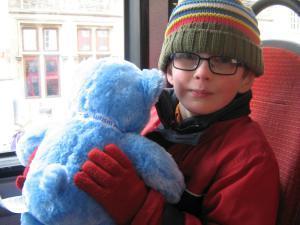
my son with his Autism Awareness bear
Today I read the chapter on autism in Andrew Solomon’s excellent book Far from the Tree, which is an insightful and often harrowing study of families where parents have children who are very different to themselves. I take my hat off to Andrew Solomon for his handling of the subject of autism, which can be a minefield. His approach struck me as both sensible and sensitive, and I turned down the corner of the page at this bit:
We need respite care, and free and satisfactory residential placements; we need positive narratives of autism that free parents from the compulsion to eliminate the syndrome…
Here are a few more points for the list:
Suitable education. From what I’ve heard from other parents, schools in the UK vary wildly in how accommodating they are to children with autism. A school that’s willing to adapt and be flexible can make all the difference between your child managing to cope and being excluded, and if he or she is excluded, don’t expect an appropriate full-time place elsewhere to be offered any time soon. That’s why I support Ambitious about Autism’s Ruled Out campaign.
Even at best, a mainstream primary school is a tough environment for a child with autism, who may well be acutely sensitive to noise and find the playground an overwhelming mass of undecipherable social signals. If I spend time at my kids’ school, I come home wondering how the staff do it day in, day out. It’s pretty full on. For my son it must be a cross between earsplitting disco, exam nightmare and seven-course banquet with very confusing cutlery, unfamiliar food, and fellow guests who speak a host of different languages and have unguessable cultural expectations. By which I mean to say, a social and sensory challenge.

current favourite toys: the robot vacuum cleaners
Prompt diagnosis. Even if everything points towards a diagnosis of autism, it takes time, simply because of the pressure on services. The unit where my son was diagnosed in 2010 saw four children a week. There has been an exponential increase in diagnoses of children with autism in Oxfordshire in recent years, which can only mean a lot of parents waiting… And diagnosis is the key to accessing the right support.
Last summer, I went on a course for parents of children with autism and their carers, run by the National Autistic Society – I’d been on the waiting list for two years, which tells you something about the level of need.
Childcare. If you want to help children with autism and their families, one way to do it is to support mothers of autistic children who want to work.
Here are some statistics, via the Papworth Trust:
84% of mothers of disabled children are not working compared with 39% of mothers of non-disabled children. Only 3% of mothers of disabled children work full time and 13% work part time.
The average income of families with disabled children is £15,270, 23.5% below the UK mean income of £19,968, and 21.8% have incomes that are less than half the UK mean.
And, from a 2001 report compiled for the all-party parliamentary group on autism, ‘Employment has been found to have considerable psychological benefits for carers…’
Shout out due here to Guideposts Trust, which runs the holiday club my son attends.
Back to Andrew Solomon’s Far from the Tree:
Parents of autistic children are often sleep-deprived. They are frequently impoverished by the cost of care. They are overwhelmed by the unrelenting needs of children who often require constant supervision. They may be divorced and isolated. They may spend endless hours fighting their insurance and health providers and the local education authority that determines what services their child will get. They may forfeit their jobs because they miss so many days to deal with crises…
Is autism on the increase?
According to Far from the Tree, the US Department of Education says that autism is growing at a rate of 10 to 17 per cent per year. Andrew Solomon has these eminently reasonable points to make on the subject:
Part of the upsurge has to do with the broadening of categories: people who might once have been classed as schizotypal or mentally retarded are now on the spectrum, as are some who would once have been thought odd but not given a diagnosis.
If you attach better services to a diagnostic category, some doctors will apply that diagnosis to children for whom it is not entirely appropriate in order to access those services.
But also:
Is autism itself also on the rise? Inconceivable time and energy have been poured into this question, and no consensus has emerged, but it seems reasonable to conclude that both diagnosis and incidence have increased. During the decade that I spent working on this book, people would hear my list of chapters and then offer to introduce me to friends who were dealing with autism at least ten times as often as they would offer introductions to people with any of the other conditions. NIMH director Thomas Insel recounted a time during the 1970s when an autistic child was admitted to Boston Children’s Hospital; the chief of service called the residents together to observe him, reasoning that they might never see an autistic child again. On Insel’s own street today, which has nine houses, two children have autism.
The deepest riddle
One of the stories Solomon recounts is about Portia Iversen and her son Dov Shestack. When Dov was nine, Portia realised he could read, which came as a shock: ‘You don’t think they can read when you don’t know they can think.’
When she understood that he could express himself, she asked him what he’d been doing all these years. ‘Listening,’ he said.
Portia Iversen has investigated the deepest riddle of autism: the relationship between what can be observed and what is going on inside autistic people.
This observation caught my eye, too:
Medicine has been too eager in many cases to dismiss parents’ insight. August Bier, a physician practising in the early twentieth century, said, ‘A smart mother often makes a better diagnosis than a poor doctor.’

a few of my autistic son’s favourite things…
What helps?
We were lucky enough to receive some good advice from the clinical psychologist who diagnosed our son. These points have stayed with me:
Much of the advice given to parents on how to connect with children with autism boils down to this – copy what they’re doing, join in with it, get down on the floor and play with them in the way they play. You don’t have to do it for hours on end – maybe just try 10 minutes a day.
This makes sense, if you think about it. If you’re trying to start a conversation with someone you don’t know, you don’t kick off by insisting they do things your way; you try to tune in to what’s going on with them.
You might as well give fish oil a go.
This is a pretty old-fashioned remedy, right? Like cod-liver oil. We give our son that Eye Q stuff – you can buy it in the supermarket, or online. He doesn’t like it off the spoon, so we put it in his morning juice. (Please, nobody tell me that’s wrong, for some reason.) I don’t know for sure that it helps - but it seems benign. Something that definitely did make a difference was a course of iron medicine; when he had the outpatient appointment that preceded his multi-disciplinary assessment and diagnosis, a blood test revealed that he was anaemic. Sorting that out lead to a big improvement in his behaviour.
The clinical psychologist also did me the service of telling me in no uncertain terms that Tom’s autism wasn’t my fault. Most mothers of children whose development is delayed probably ask themselves at some point if it’s because of something they’ve done. Back in the bad old days, when it was held that autism was caused by ‘refrigerator mothers’, this, my worst fear, would almost certainly have been confirmed rather than refuted by the medical experts.
It doesn’t seem to have occured to anyone, during the refrigerator mother era, that caring for an unresponsive or extremely fractious and sleepless child might leave a woman shell-shocked, depressed and ambivalent about parenting – in other words, that parenting is two-way, and to some extent, the mother is made by the baby just as the baby is made by the mother.
Here’s another extract from Far From the Tree:
In 1965, parents created the National Society for Autistic Children; at the first meeting, they are said to have worn name tags in the shape of little refrigerators. ‘We mothers would have liked an apology,’ said Eustacia Cutler, mother of the prominent autistic intellectual Temple Grandin. We deserve it. And so do the fathers.’
Do watch Temple Grandin, the biopic with Claire Danes in the lead role – it’s brilliant.
The students who took hidden children out into the world
Writing about Far from the Tree has reminded me of the Ely scandal, which prompted the inquiry that lead to the beginning of the end of widespread use of long-stay institutions to house people with learning disabilities.
Can somebody please make a film about the first group of people from a long-stay mental institution (Ely, a few years after the inquiry) who went out to live in the community, helped by a household of Cardiff students?
From an account by David Brindle, in the Guardian – ‘Honour for Jim Mansell, who brought learning
disability out of the shadows’: ‘In 1970, there were 60,000 adults and children with learning disabilities living confined, institutional lives in long-stay hospitals. That autumn, a young student [Jim Mansell] newly arrived at Cardiff University agreed to help take a group of children from the city’s Ely hospital to the cinema on a Saturday morning. From that point on, the hospitals stood no chance… The children had shaven heads because lice were endemic, Mansell said, and “I remember not enough underwear, so people [were] wearing pillowcases pinned around them, trousers held up with pins”.
He continued: “We took a crocodile of these children across the road, out of the hospital, and through a council estate to a cinema, and the people on the estate came out … to press money into our hands to buy things for these children because they were in such obvious need. We were so angry about what was going on, we formulated the idea that really these kinds of places shouldn’t exist and people should be able to live in houses with whatever support they needed in the community.”
Fears for the future and the Winterbourne View scandal
Swimming in the Thames to raise funds for Ambitious about Autism
The moment I found out about my son’s autism
January 30, 2014
Ebook publication day for After I Left You
Today is the ebook publication day for After I Left You. We have just celebrated with Waitrose passion cake and cups of tea. It feels strange… but lovely. It’s out!
You can buy After I Left You from Amazon and find out about other ebook formats from the Transworld website (click on buying options to see a list of suppliers). And here I am reading the first page.
The black bars are censoring the background mess in my house… No, not really – my other half and I recorded this last night using our new camera and we are on a bit of a learning curve! It took two minutes to film and rather longer to manage to upload! I hope it whets your appetite and leaves you wanting to find out what happens next.
@harrietbourton @AlisonLMercer Aw, *fistbump*, ladies.
— Sarra Manning (@sarramanning) January 30, 2014
@harrietbourton @sarramanning @AlisonLMercer Congratulations Sarra and Alison. Happy day at Transworld Towers xx
— Tammy Cohen (@MsTamarCohen) January 30, 2014
happy publication day to @AlisonLMercer for After I left You! I am nearly finished! Review up soon xx
— Laura (@Midnightstar3) January 30, 2014


January 15, 2014
Christmas with my child with autism
 The Christmas before my son was diagnosed with autism, back in 2010, was pretty tricky. I remember at least one spectacular meltdown in front of a shocked visitor! At that point a full diagnosis was still six months away. We didn’t know for sure why he was behaving the way he did, and that uncertainty only added to the strain.
The Christmas before my son was diagnosed with autism, back in 2010, was pretty tricky. I remember at least one spectacular meltdown in front of a shocked visitor! At that point a full diagnosis was still six months away. We didn’t know for sure why he was behaving the way he did, and that uncertainty only added to the strain.
He spent a lot of time involved in solitary play, twiddling objects – straws were a favourite and he had a whole bank of them lined up. If someone he didn’t know well came to the house, he would turn his back on them and twiddle furiously, humming as if to drown them out. Even then, he was showing some signs of interest in Christmas – he liked to look at the lights outside people’s houses – but insisted on stopping at each drainhole we passed in the street and getting down on the ground to look at it.
He was three years old and, though we didn’t know this, he was anaemic. Once that was spotted and he was given an iron supplement, things began to improve. We also learned more about autism and how to support him, and over time, he has developed and changed, and has coped with situations that would once have seemed like impossible challenges.
I’m pleased to say that this year we had a really good Christmas (bar one or two glitches!) We now have a much better idea of how to help prepare him for new experiences by using social stories, and his language skills are much better and he’s more settled. We can still get caught out and there will always be setbacks, but it’s a lot easier than it was.
Getting through the Christmas show
Back in 2010, one of the experiences that made it most obvious that Tom was different to other children in his peer group was the Christmas show. You get used to your own child, but when you see him or her with others, the differences become very obvious.
I still find the Christmas show nerve-racking – I know it’s very weird and intense for Tom, and you can’t really prepare for the strangeness of standing up on a stage in front of a hall packed with expectant parents. But at the same time I want him to be part of it and enjoy it, if possible. And he does! He is at a mainstream school, and the staff have always been brilliant at managing him in this unusual, high-pressure situation.
Last year he came on at the end of the show and said ‘Thank you for coming’. This year he made it all the way through, sitting with the other children when he wasn’t on stage and playing on the ipad with the sound turned down. When it was his turn to go up and do a song and dance, one of his friends took him by the hand to guide him up there.
He was very clear that he wanted to take part, and we have a lovely picture of him beaming in his costume. It’s all practice – next time it will be even easier!
Easy like Christmas morning
 We always spend Christmas at home, and make sure there are intervals between visiting and having visitors. We have to try and keep it relaxed for everybody, because if we get stressed so does Tom. He has always loved Christmas lights, but this year he got into carols and Christmas songs in a big way – plus light-up Christmas toys. And he now eats the chocolates in his advent calendar! He passed on most of Christmas dinner, but was very happy with some of the little sausages and mash. And this year he helped unwrap his own presents! He got some practical things, like clothes, and lots of sensory toys, including playbeads, which are a bit like playdough, and toys that make sounds, like his megaphone toy.
We always spend Christmas at home, and make sure there are intervals between visiting and having visitors. We have to try and keep it relaxed for everybody, because if we get stressed so does Tom. He has always loved Christmas lights, but this year he got into carols and Christmas songs in a big way – plus light-up Christmas toys. And he now eats the chocolates in his advent calendar! He passed on most of Christmas dinner, but was very happy with some of the little sausages and mash. And this year he helped unwrap his own presents! He got some practical things, like clothes, and lots of sensory toys, including playbeads, which are a bit like playdough, and toys that make sounds, like his megaphone toy.
He also went to his Christmas school disco for the first time, which was an absolute triumph – brilliant! He got a best dancer certificate! The lights were very intense for him, I could tell, but it was great to see him grooving! And attempting to learn the moves to ‘I am the music man…’
We had some other firsts over Christmas too. It hasn’t seemed like the right time to try these things till now – but I think Tom was ready and we were too.
Autism-friendly cinema screening of Frozen at the Odeon in Oxford – the first time all four of us have been to the cinema together, ever.
We met Santa on the Cholsey and Wallingford railway – the Bunkline. Brilliant, very mellow.
We went to a relaxed performance of Father Christmas and the Icicle Bicicyle at the Oxford Playhouse. They sent us a social story all about it in advance, so he knew what it was going to look like, and he got the chance to sing Jingle Bells! I have never seen him so engaged in any performance. He was a bit skittish and got up and ran round once or twice, but they were very good and just calmly reminded him to sit down. It was a really magical experience for both of us.
Tom also went to his holiday club at Kingfisher School in Abingdon, which is run by the Guideposts Trust – that’s his holiday childcare while I am working and it’s also really good fun for him as they do different activities and have great facilities – like the ball pool.
And he signed his name on his thank you letters! We did have one really bad day after Christmas when it all went pear-shaped and he got very upset and scratched his face. But there was a lot more good than bad.
There are various charities that offer support to families over the Christmas period and all year round:
Ambitious about Autism
The National Autistic Society
Autism Family Support – sends out mailings about what’s going on in Oxfordshire
Guideposts Trust
I also hear good things about Oasis and parent support groups such as Shift. Another great charity is Cerebra.
When we put our tree up, Tom said our living room had turned into a Christmas living room – but he also understood when Christmas was finished. He’s still singing the songs though. And we are already looking forward to next Christmas!


January 2, 2014
After I Left You ebook first! Publication update
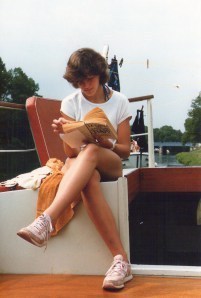
Will After I Left You be your summer holiday reading?
OK, people, here’s the news: the publication date for the paperback of my next novel, After I Left You, has been moved back to July 2014 − BUT the ebook will be published at the end of January.
So if you love your Kindle or e-Reader, you’ll have a long head start. If you prefer a paperback, the timing could be just right for you to take After I Left You on your summer holiday…
Isn’t reading a big part of the joy of going on holiday? In the above pic I’m deep in John le Carré’s The Honourable Schoolboy while on a boat holiday (check my 80s hairdo – I was a teenager). One of my best holiday reads ever was Erica Jong’s Fear of Flying, the one and only time I got some winter sun. I’ll always associate that book with the luxury of escaping from Britain in January.
After I Left You: ebook in January, paperback in July
Sometimes there are changes late in the day in the world of publishing – it’s just how it goes. If you were looking forward to getting your hands on the paperback of After I Left You, I promise you it will be worth the wait! I love paperbacks myself – I spend a lot of my time staring at screens, so it feels like a treat to read a story in this format. It does mean we have stacks of books everywhere, but I kind of like that too – I’d miss them if they weren’t around.
In the end, the paperback of After I Left You will have a much better chance of reaching as many readers as possible as a summertime book. Still, I’m really pleased that the ebook is coming out at the end of January and if this is the way that you like to read, I hope you’ll try it, love it and recommend it! There is nothing like word of mouth!
You can see a range of suppliers for both the paperback and ebook of After I Left You on the website of Transworld, my brilliant publishers (have a look round, they have lots of fantastic authors and I’m very lucky to be in such good hands).
If you’d prefer to read the paperback, it should be stocked by all good bookstores, including local independents. Independent bookshops such as Mostly Books in Abingdon are brilliant at ordering books in – I did my Christmas shopping at Mostly Books by sending an email with a long list and picked them up from the shop the next day. Mostly Books is also happy to post books to you.
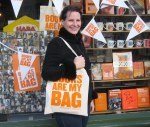
Outside Mostly Books in Abingdon. Books Are My Bag!
You can also pre-order the paperback of After I Left You or the ebook from Amazon.
What people have said so far about After I Left You…
Other writers have made some lovely comments about After I Left You. Alice Peterson, author of Monday to Friday Man (which knocked Fifty Shades of Grey off the Kindle no 1 spot!) had this to say about it: ‘A lovely absorbing read, so evocative of student life. Alison Mercer really captures the passion of falling in love for the first time.’ Tamar Cohen, author of The Mistress’s Revenge, said, ‘Alison Mercer has expertly spun an engrossing story about love, secrets and second chances.’
You’ll also find a couple of lovely reader reviews on Goodreads. These readers won proof copies of After I Left You in a giveaway and I was really pleased they enjoyed it. At the risk of coming over all Gwyneth Paltrow at the Oscars, or at least sounding a bit corny, I found it very emotional to write, so it’s lovely when readers respond to that.
Right – now I have to crack on with writing the next one!
Find out about the German edition of After I Left You
The cover of After I Left You
After I Left You and the five rules for writing an Oxford novel
Love stories and After I Left You
The story behind the story: about writing After I Left You





